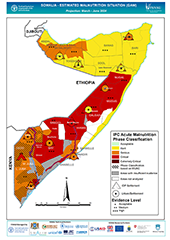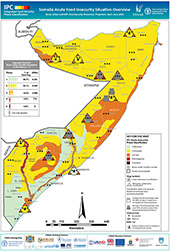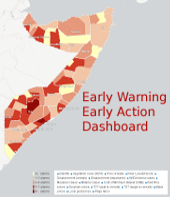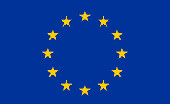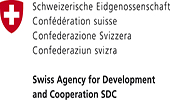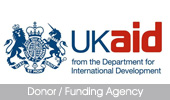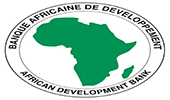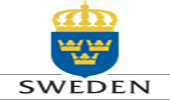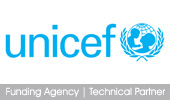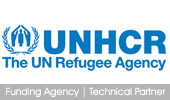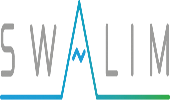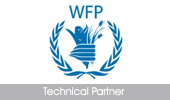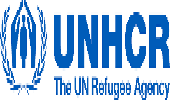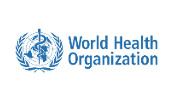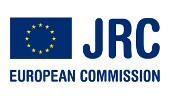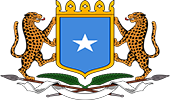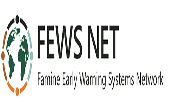Somalia continues to face large scale food insecurity compounded by poor rainfall and drought
Issued: February 8, 2016
38 percent of the population classified as acutely food insecure; 304,700 children acutely malnourished
February 8, 2016, Nairobi/Washington – Somalia will continue to face large-scale food insecurity between now and June 2016 as a result of poor rainfall and drought conditions in several areas, trade disruption, a combination of protracted and new population displacement, all of which is exacerbated by chronic poverty. Acute malnutrition remains high in many parts of the country.
The latest findings from a joint countrywide seasonal assessment by the Food Security and Nutrition Analysis Unit for Somalia (FSNAU, a project managed by the Food and Agriculture Organization of the United Nations), and the Famine Early Warning Systems Network (FEWS NET), a project funded by USAID, indicate that 931,000 people will be in Crisis (IPC Phase 3) and 22,000 more people in Emergency (IPC Phase 4) across Somalia through June 2016. Internally displaced persons (IDPs) represent 68 percent of the total number of people in Crisis and Emergency, rural populations (26 percent) and urban populations (6 percent). Approximately 3.7 million additional people across the country are classified as Stressed (IPC Phase 2) through mid-2016. In total, the assessment reports that nearly 4.7 million people or 38 percent of the total population of Somalia are acutely food insecure and will be in need of humanitarian assistance between now and June 2016.
The assessment involved 39 separate nutrition surveys conducted from October to December 2016 by FSNAU and partners across Somalia. Results from these surveys indicate that an estimated 304,700 children under the age of five were acutely malnourished at the time of the survey. This includes 58,300 children under the age of five that are severely malnourished and face increased risk of morbidity and death. Despite changes in seasonal food security and livelihood outcomes and continued humanitarian interventions, Critical rates of acute malnutrition (i.e. 15% or more Global Acute Malnutrition – GAM) persist among several population groups. This shows the protracted nature of the nutrition crisis among these groups. Almost all of the past seven seasonal assessments (conducted twice a year) have reported Critical GAM rates amongst: Bari Urban, Garowe IDPs, Galkayo IDPs, Mataban District, Beletweyne District, Bay Agropastoral, Dollow IDPs, North Gedo Pastoral and North Gedo Riverine.
Urgent nutrition and health support for the acutely malnourished is needed now and through mid-2016. However, this is not enough for populations experiencing persistently high levels of acute malnutrition. They need additional multifaceted interventions aimed at addressing the underlying causes and contributing factors.
Urgent lifesaving humanitarian assistance and livelihood support is required for populations in Emergency and Crisis (IPC Phases 4 and 3) through June 2016. Populations experiencing Stressed (IPC Phase 2) acute food insecurity remain highly vulnerable to shocks that could push them back to Crisis or Emergency (IPC Phases 3 or 4). They should be supported in order to protect their livelihoods and boost their resilience to shocks.
Climate continues to play a determinant role in shaping food security patterns throughout rural Somalia in both positive and negative ways. Most parts of Southern and Central Somalia received average to above-average Deyr (October-December) rains both in terms of amount as well as spatial and temporal distribution. As a result, cereal production, including off-season production expected in March, was estimated to be 130,100 metric tons, which is 28 percent above the long-term average (1995-2014) and 18 percent above the five-year average (2010-2014).
Despite a strong global El Niño, the anticipated heavier than normal rains and consequent riverine and flash floods in central and southern Somalia did not materialize during the 2015 Deyr season. Riverine flooding during the season has been moderate (Middle Shabelle, Juba and Gedo regions), although it still caused damage to some standing crops and agricultural lands.
The situation is very different in the North. Rainfall during the 2015 Gu (April-June) and Karan (August-September) were below average. This had a severe impact on the Gu/Karan cereal harvest in the Northwest agropastoral livelihood zones, which is estimated at 7,700 metric tons. This is 87 percent lower than the five-year average (2010-2014).
Below normal rainfall and drought conditions prevailed in large portions of Northwest and Northeast Somalia leading to large-scale
abnormal outmigration of livestock, rising water prices and sharp increase in debt levels among poor households. In Guban Pastoral livelihood zone of Awdal Region in the Northwest, unseasonal moderate rains in November followed by near normal Hays rains in December contributed to a moderate improvement in terms of pasture and water availability. However, due the large influx of livestock in-migration from drought affected parts of Djibouti, Ethiopia and other adjacent livelihoods and the dry Jilaal season, the improved pasture and water will likely be exhausted soon. Drought conditions are expected to prevail until at least the start of the 2016 Gu season when rainfall brings some relief to nearby drought-affected areas and opens up the possibility for livestock migration to other areas.
Current forecasts point towards a near-average 2016 Gu season rainfall in Somalia. However, during the El Niño transition period, close monitoring is required.
In most pastoral and agropastoral livelihood zones in South and Central Somalia, livestock production and reproduction has continued to improve, contributing to improved food security outcomes. Pasture and water remain average in most regions, except in large parts of Northern Inland pastoral (NIP) and Northwestern Agropastoral of the North and pocket areas in coastal parts of South- Central and Dolow district of Gedo region. Abnormal migration has been reported from drought-affected areas of Bari and Sanaag Regions and parts of Nugal Region to areas that received better rainfall in the lower part of Nugal and North Mudug Regions.
A harsh Jilaal dry season (January-March) is expected to lead to increased cost of water and water trucking and increased livestock off-take (increased selling and death), particularly in drought-affected areas of Northeast and Northwest. Pasture, browse, and water availability are expected to improve following the start of projected near normal Gu rains in April.
Areas and Populations of Concern
Populations in Crisis and Emergency (IPC Phases 3 and 4) are priorities for food security and livelihoods support programming. They are found in large proportions (10 percent or more of their respective total regional population) in the following regions: Banadir (22%), Bari (11%), Awdal (10%) and Sanaag (10%). The prevailing drought conditions and consequent food security outcomes are expected to worsen at least until the start of Gu rains in April in Awdal, Bari and Sanaag Regions and deserve close monitoring.Other priority groups include poor and vulnerable urban populations in the South that have been affected by trade disruption due to insurgent activities in Bulo Burto (Hiran Region), Hudur and Wajid (Bakool Region), and Dinsoor (Bay Region).
A nutrition situation is considered Critical when Global Acute Malnutrition (GAM) prevalence is 15 percent or higher or if 10.7 percent or more of children have Mid-Upper Arm Circumference (MUAC) below the 125 millimeters (mm) threshold. Accordingly, the following population groups have Critical rates of acute malnutrition and are considered hotspots in need of urgent humanitarian response interventions:
-
Guban Pastoral (Awdal and W. Galbeed Regions)
-
Bosaaso IDP (Bari Region)
-
Bari Urban (Bari Region)
-
Garowe IDPs (Nugaal Region)
-
Galkayo IDPs (Mudug Region)
-
Coastal Deeh of Central (Mudug and Galmudug Regions)
-
Mataban District (Hiran Region)
-
Beletweyne District (Hiran Region)
-
Bay agro-pastoral (Bay Region)
-
North Gedo Pastoral (Gedor Region)
-
North Gedo Riverine (Gedo Region)
-
South Gedo Pastoral (Gedo Region)
-
Dolow IDPs (Gedo Region)
Although GAM rates among Mogadishu IDPs are relatively lower (10-14.9% GAM or Serious), they deserve particular attention as they account for 51 percent of the total number of acutely malnourished IDP children under-five found at the time of the survey in the country.
Click this link to download full report.
-
